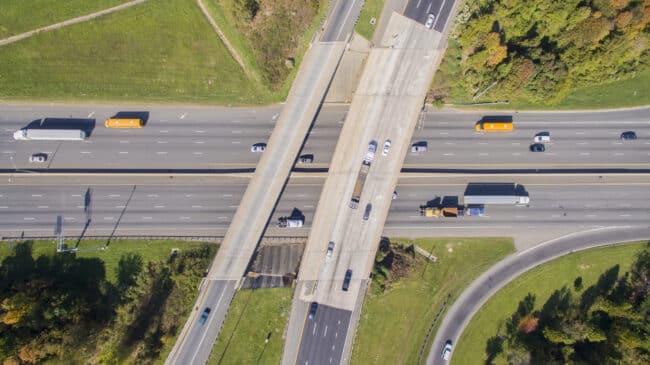As Congress debates a potential infrastructure package and surface transportation reauthorization bill, some lawmakers have raised questions about various innovative financing practices that serve as alternatives to conventional government funding. One financing tool, private activity bonds, has generated some confusion due to the various types, tax treatments of them, and volume caps on them.
What follows is a brief explanation of private activity bonds and a discussion of the specific issues facing private activity bonds when used in highway projects.
Under the federal tax code, bonds issued by state and local governments are broadly categorized as either governmental bonds or private activity bonds (PABs). Interest income on governmental bonds, like municipal bonds, is not subject to taxation. In contrast, interest income on private activity bonds, as with commercial bonds, is generally taxed.
Government-issued bonds are subject to two private business tests (26 U.S.C. § 141(b)). If both conditions are met, the bond interest income is generally taxable.
However, Congress has provided tax exemptions for some uses of private activity bonds. These are called qualified PABs. Most relevant to the infrastructure discussion are a subset of qualified PABs called exempt facility bonds. Section 142 of the Internal Revenue Code provides for 15 types of exempt facility bonds:
- Airports;
- Docks and wharves;
- Mass commuting facilities;
- Facilities for the furnishing of water;
- Sewage facilities;
- Solid waste disposal facilities;
- Qualified residential rental projects;
- Facilities for the local furnishing of electric energy or gas;
- Local district heating or cooling facilities;
- Qualified hazardous waste facilities;
- High-speed intercity rail facilities;
- Environmental enhancements of hydroelectric generating facilities;
- Qualified public educational facilities;
- Qualified green building and sustainable design projects; and
- Qualified highway or surface freight transfer facilities.
Of these 15 uses, nine could be (depending on government or private ownership) subject to an annual state volume cap: mass commuting facilities, water furnishing facilities, sewage facilities, solid waste disposal facilities if privately owned, qualified residential rental projects, facilities for the local furnishing of electric energy or gas, local district heating or cooling facilities, qualified hazardous waste facilities, and high-speed intercity rail facilities if privately owned (but only 25% of the bond issue is counted against the cap).
This qualified private activity bond volume cap is subject to annual cost-of-living adjustments (26 U.S.C. § 146(d)). For 2021, each state’s cap is determined by the greater of $110 per capita or $324,995,000 (IRS Rev. Proc. 2020-45).
In addition, three more exempt facility uses are subject to separate caps. Qualified public educational facilities are subject to an annual state volume cap determined by the greater of $10 per capita or $5 million (26 U.S.C. § 142(k)(5)(A)). Qualified green building and sustainable design projects are subject to a $2 billion lifetime national volume cap (26 U.S.C. § 142(l)(7)(B)). And qualified highway or surface freight transfer facilities are subject to a $15 billion lifetime national volume cap (26 U.S.C. § 142(m)(2)(A)).
Since they were established for highway uses by the SAFETEA-LU surface transportation reauthorization of 2005 (the Safe, Accountable, Flexible, Efficient Transportation Equity Act: A Legacy for Users), qualified private activity bonds have been very important in highway public-private partnerships.
As my Reason Foundation colleague Baruch Feigenbaum recently noted:
In most cases PABs provide financing for 20-30% of the project’s total cost. For megaprojects, $12 billion in private activity bonds led to $45 billion in project activity over the past 15 years. Without PABs many of these projects would not have been feasible.
Unfortunately, the $15 billion lifetime national volume cap on qualified private activity bonds for highway uses has been reached. As of May 24, 2021, the Department of Transportation’s Build America Bureau reports that all but $10.4 million (or 0.07%) of that $15 billion maximum has been issued or allocated. If Congress wishes to keep highway public-private partnerships (P3s) as a viable option for project delivery—and one that can save taxpayers many billions of dollars—it will need to increase or eliminate the cap on highway exempt facility qualified PABs.
Finally, it is important to note that raising or eliminating the cap on Section 142(m) highway and surface freight transfer uses would not impact any other type of qualified PAB or qualified PAB cap, so past or ongoing controversies with the use of PABs in sports stadia or low-income housing are not germane to this discussion.
But if lawmakers really wish to promote more private investment in public-purpose surface transportation infrastructure—including rebuilding the aging Interstate Highway System—Reason Foundation’s Robert Poole has proposed a series of reforms that are needed for governments to harness the potential of private capital and project management expertise.
Discussion drafts of legislation to reform both exempt facility bonds and the Interstate System Reconstruction and Rehabilitation Pilot Program are available here.

